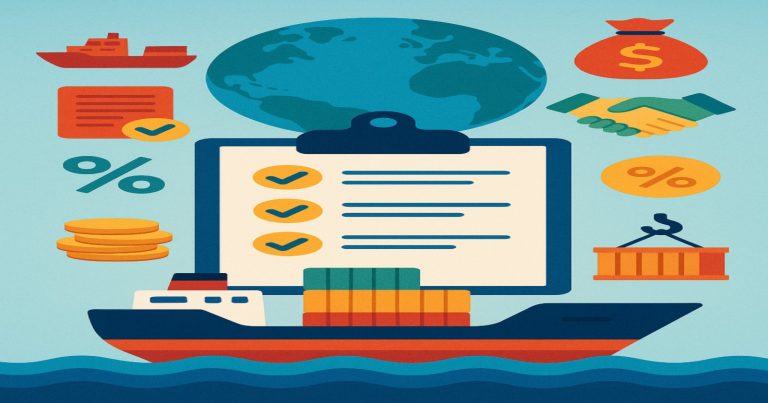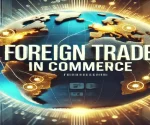The EXIM Policy, or Export-Import Policy, is a crucial framework that guides a country’s trade practices, balancing exports and imports to enhance economic growth. In India, the EXIM Policy is formulated every five years, with periodic updates to address evolving trade dynamics and global challenges. Features of EXIM policy includes the measures that India has adopted to increase exports and minimize imports. This policy is central to promoting export-oriented growth, reducing trade imbalances, and ensuring seamless international trade processes.
What is EXIM Policy?
EXIM Policy refers to the guidelines, rules, and regulations that govern the trade of goods and services between a country and the global market. It acts as a strategic roadmap for economic growth through enhanced trade relations. In India, the EXIM Policy is framed and implemented by the Directorate General of Foreign Trade (DGFT), functioning under the Ministry of Commerce and Industry.
Objectives of EXIM Policy
- Promote Exports: Facilitate the growth of exports by offering incentives and reducing trade barriers.
- Reduce Import Dependency: Regulate imports to support domestic industries and reduce foreign exchange outflows.
- Enhance Global Competitiveness: Equip exporters with tools to compete in international markets effectively.
- Simplify Trade Procedures: Streamline documentation and approval processes to make trade easier and faster.
- Encourage Foreign Investment: Attract global investors by creating a favorable trade and economic environment.
The EXIM Policy ensures India’s trade adheres to international standards, providing a competitive edge to domestic industries and supporting sustainable economic development.
Features of EXIM Policy
The features of EXIM Policy are integral to shaping India’s trade landscape, fostering a business-friendly environment, and addressing global economic trends. Below, we delve into its primary aspects:
Increase in the Number of Export Items
India’s EXIM Policy encourages diversification in its export basket to reduce dependency on a limited range of goods. By promoting non-traditional items and value-added products, the policy broadens export opportunities for Indian businesses.
- Identification of High-Demand Products: The government identifies products with potential in global markets, such as electronics, processed foods, IT services, and pharmaceuticals.
- Incentives for New Sectors: Emerging industries like renewable energy and technology-driven manufacturing receive specific incentives to expand exports.
- Support for MSMEs: Small businesses receive subsidies and financial assistance to help them compete globally.
Export diversification minimizes risks associated with over-reliance on a few products or markets and enhances India’s global trade stability.
Special Economic Zones (SEZs)
Special Economic Zones (SEZs) are a vital feature of India’s EXIM Policy. They are designed to attract foreign investment and boost exports through economic and infrastructural incentives.
- Tax Exemptions: SEZs offer income tax holidays for a specified period, enabling businesses to save costs and reinvest in operations.
- State-of-the-Art Infrastructure: These zones provide advanced facilities such as reliable utilities, transport networks, and connectivity to ports and airports.
- Simplified Procedures: Businesses in SEZs enjoy streamlined customs clearances and reduced compliance requirements.
SEZs act as catalysts for regional development, employment generation, and export promotion, driving India’s economy forward.
Role of Public Sector Agencies
India’s EXIM Policy highlights the pivotal role of public sector organizations in facilitating and promoting trade. Agencies like the Export Credit Guarantee Corporation (ECGC) and the EXIM Bank provide essential financial and infrastructural support to exporters.
- Export Financing: The EXIM Bank offers loans and credit lines to exporters, especially for large-scale international projects.
- Risk Mitigation: The ECGC provides insurance against payment defaults, safeguarding exporters from geopolitical or financial risks.
- Trade Promotion: Organizations like the India Trade Promotion Organisation (ITPO) promote Indian products through international trade fairs and exhibitions.
Public sector agencies ensure exporters, especially small businesses, have access to financial resources and market opportunities to compete globally.
Restriction-Free Export Policy
One of the defining features of the EXIM Policy is its liberal approach to exports. By minimizing restrictions, the government enables exporters to access global markets more efficiently.
- Reduction in Licensing: Exporters are no longer required to obtain licenses for many goods, simplifying the export process.
- Removal of Quantitative Restrictions: Limits on the quantity of goods that can be exported have been eliminated for most sectors.
- Simplified Documentation: Exporters benefit from reduced paperwork, leading to faster approvals and reduced costs.
This liberal approach enhances trade efficiency and allows businesses to focus on expanding their global presence.
Liberalization of Export-Oriented Imports
To support export-oriented industries, the EXIM Policy facilitates the import of inputs such as raw materials, machinery, and technology at reduced costs. This ensures that Indian exporters remain competitive globally.
- Duty-Free Import Schemes: Programs like the Advance Authorization Scheme and Duty-Free Import Authorization (DFIA) allow exporters to import goods without paying duties.
- Reduction in Import Tariffs: Lower import tariffs for specific sectors reduce production costs and improve global competitiveness.
- Credit Support: Financial assistance is provided to help exporters import the necessary resources for production.
This feature ensures that industries can source high-quality inputs without burdening their finances, enabling them to focus on delivering world-class products.
Convertibility of Rupee
The EXIM Policy introduced rupee convertibility under the Liberalized Exchange Rate Management System (LERMS). This system facilitates smooth foreign exchange transactions, benefiting both exporters and importers.
- Ease of Transactions: Exporters and importers can convert foreign currencies into rupees (and vice versa) seamlessly, reducing trade-related delays.
- Currency Stability: Rupee convertibility attracts foreign investors by providing a stable currency framework.
- Global Integration: It aligns India’s trade mechanisms with international standards, making the country a more attractive trade partner.
This measure strengthens India’s global trade relations by fostering trust and reliability in financial transactions.
Devaluation of Rupee
As a strategic move, the EXIM Policy occasionally incorporates rupee devaluation to enhance the competitiveness of Indian goods in international markets.
- Boost to Exports: A weaker rupee makes Indian goods more affordable for foreign buyers, increasing demand and export revenues.
- Reduced Imports: Devaluation discourages imports by making them costlier, thus supporting domestic industries.
- Improved Trade Balance: By encouraging exports and curbing imports, devaluation helps reduce trade deficits.
While devaluation is a double-edged sword, it has been effectively used under the EXIM Policy to manage trade dynamics.
Current Status of EXIM in India
The current EXIM Policy (2020-2025) emphasizes digitization, resilience, and sustainability. Some noteworthy updates include:
- Digital Platforms: The adoption of electronic platforms for trade documentation has reduced processing times and enhanced transparency.
- Green Trade Initiatives: Promoting exports of eco-friendly products and reducing the carbon footprint of trade processes.
- Enhanced FTAs: Strengthened trade relations through Free Trade Agreements with key partners like the UAE, Australia, and the UK.
India’s exports have grown significantly in sectors such as IT, pharmaceuticals, and engineering goods, but challenges like global economic uncertainties and trade deficits require dynamic policy adjustments.
EXIM Policy FAQs
What are the key features of EXIM Policy?
The EXIM Policy emphasizes export liberalization, SEZ development, rupee convertibility, and facilitating export-oriented imports. It aims to boost exports while ensuring sustainable trade practices.
How do SEZs contribute to the EXIM Policy?
SEZs provide tax benefits, advanced infrastructure, and simplified procedures to enhance exports and attract foreign investment.
How does the EXIM Policy support exporters?
Exporters benefit from financial assistance, duty-free import schemes, and reduced licensing requirements, enabling them to compete in global markets.
What role does rupee convertibility play in EXIM Policy?
Rupee convertibility facilitates smooth foreign exchange transactions, ensuring ease of trade and attracting international investment.
How does the EXIM Policy address trade sustainability?
The policy promotes eco-friendly exports and digitization, aligning trade practices with global sustainability standards.


